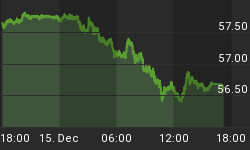When a sizeable correction happens in U.S. equity markets, the major indices usually do not all make their tops in the same way or at the same time. While several indices are showing signs of exhaustion, as we have documented in recent weeks, the NYSE Composite Index (INDEXDJX:NYA) (NYSEARCA:NYC) presents the clearest Elliott wave structure that can be counted as complete.
Our primary Elliott wave count for the NYSE Composite Index is shown on the weekly candle chart below. The large five-wave [i]-[ii]-[iii]-[iv]-[v] structure from the September 2011 low includes an extended wave [iii], which is a common occurrence in strongly trending markets. We count the January 2014 test of the lower channel boundary as wave [iv], and last week's new high meets the criteria for being a completed final wave [v].

Strictly from an Elliott wave standpoint, it is possible for wave [v] in this count to be as yet unfinished. It would violate no rules if price went on to make a series of two more slightly higher highs. However, other signals coincide to suggest that now is a favorable time for the index to begin its correction. For example, price is testing the midline of a channel that has worked very well since 2011, and the midline can be expected to act as resistance. Price also has poked slightly above the 2007 high at the same time that we see negative momentum divergence (a higher price high with a lower momentum high).
If price declines from around its present level, bears would hope to see a retest and breach of the lower channel boundary. However, since there is not yet any confirmation that the trend has changed, it is too early for most traders to consider taking short positions on the weekly timeframe. Cautious and sensible bears would watch for the channel boundary to be breached and would look for a lower high, or possibly a "kiss back" of the channel line from below, before initiating a trade.
In a separate article posted at our website this week, we show similar developments in the NASDAQ 100 Index (INDEXNASDAQ:NDX) in terms of channel resistance and momentum exhaustion.
Follow us on Twitter @TradingOnMark















